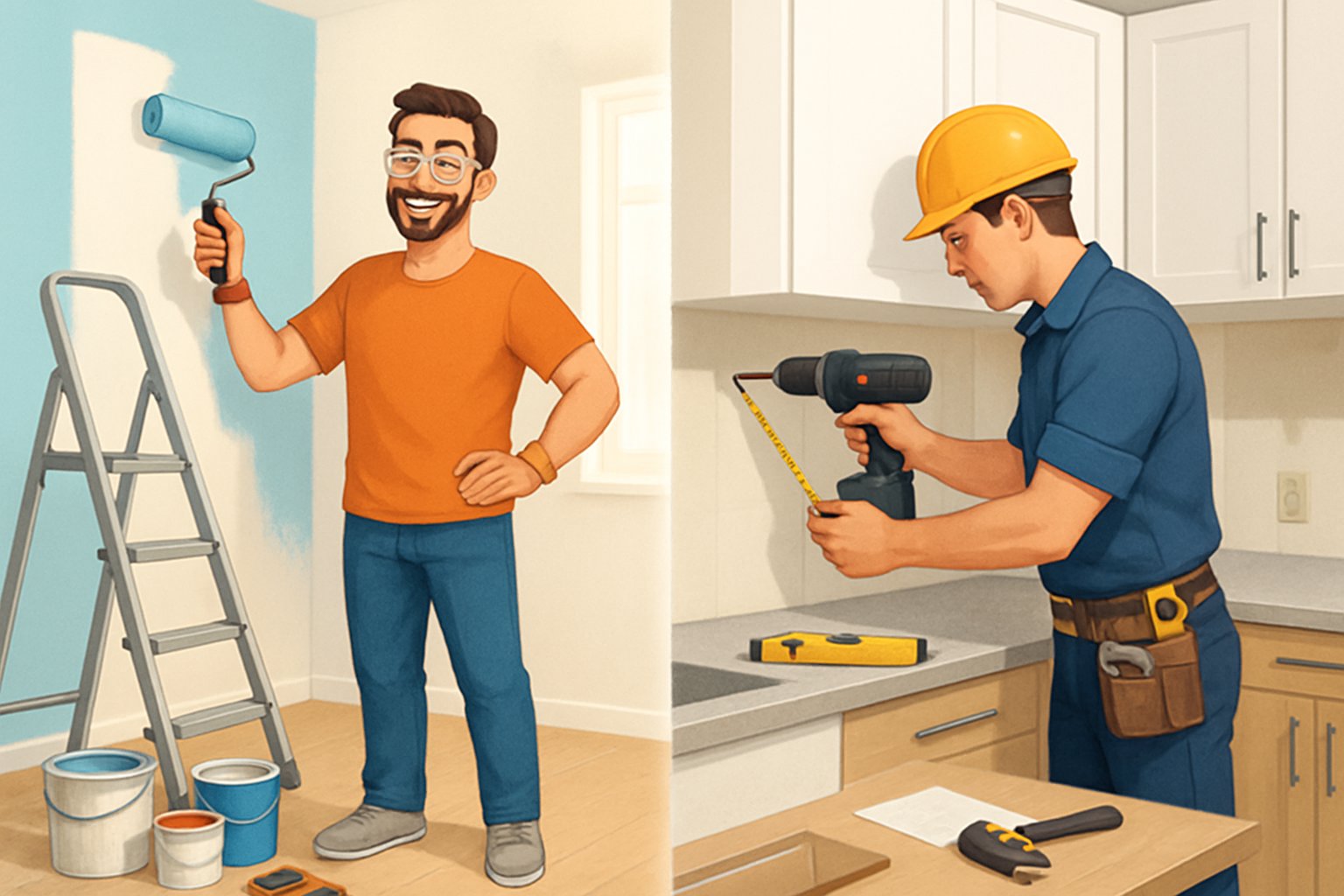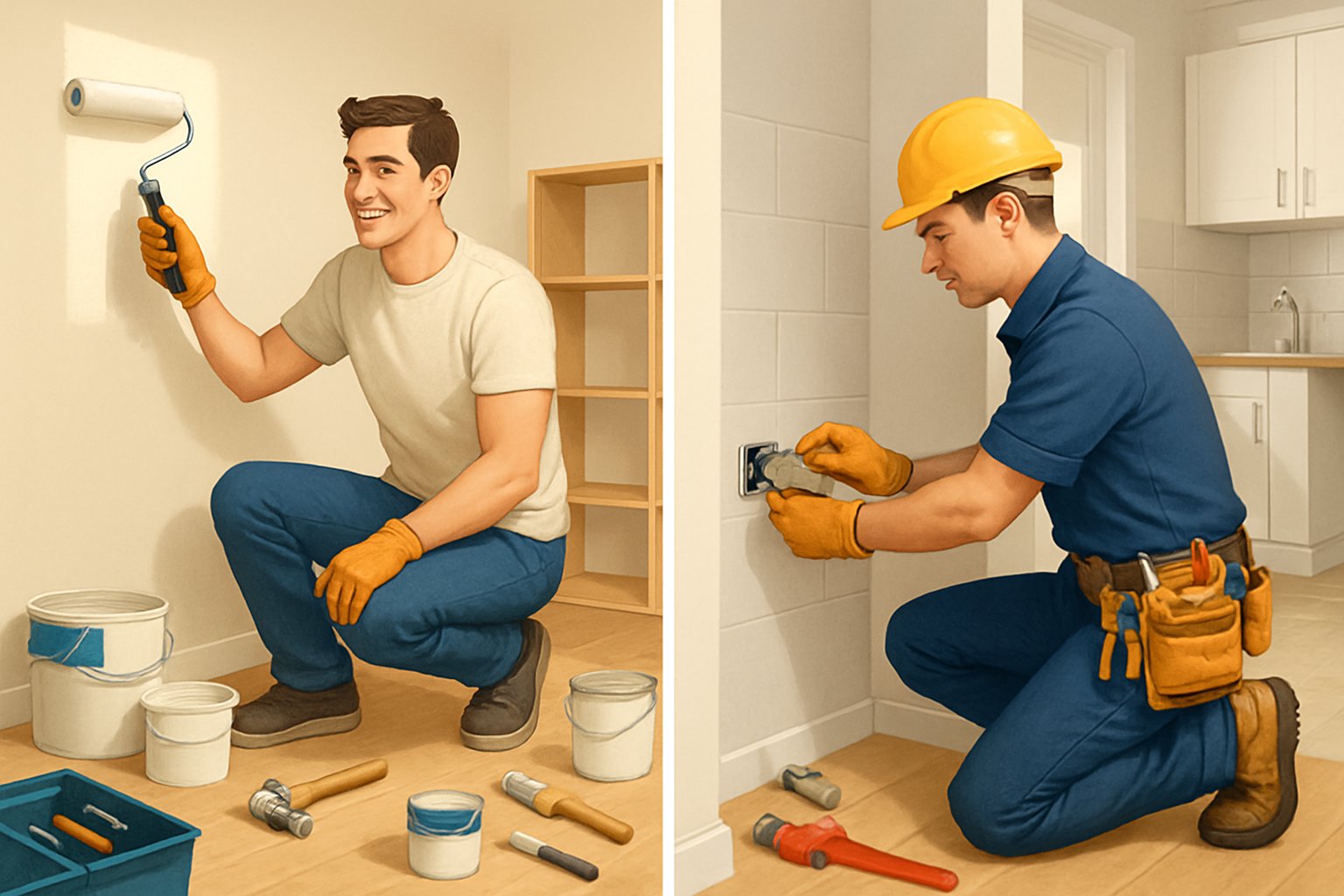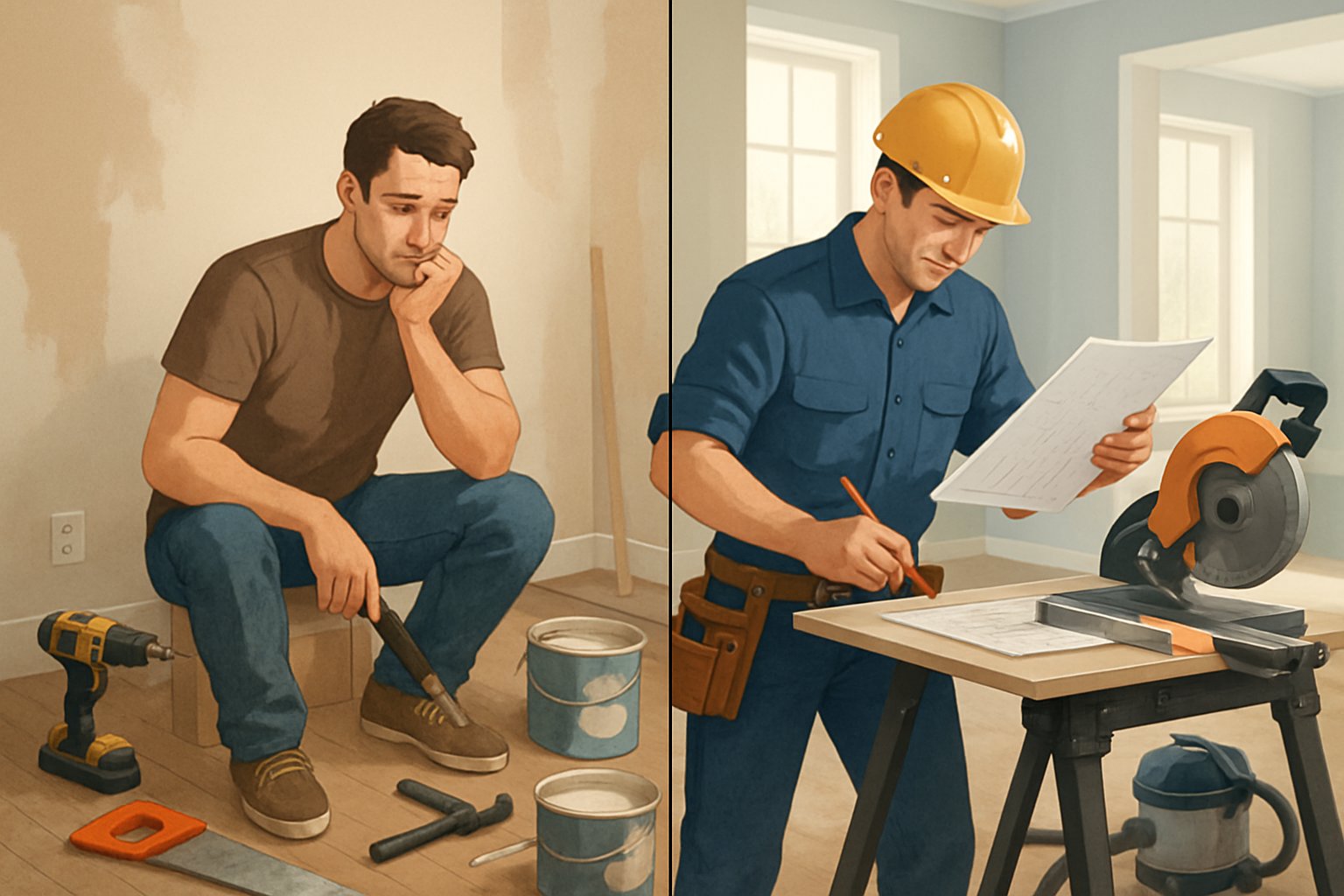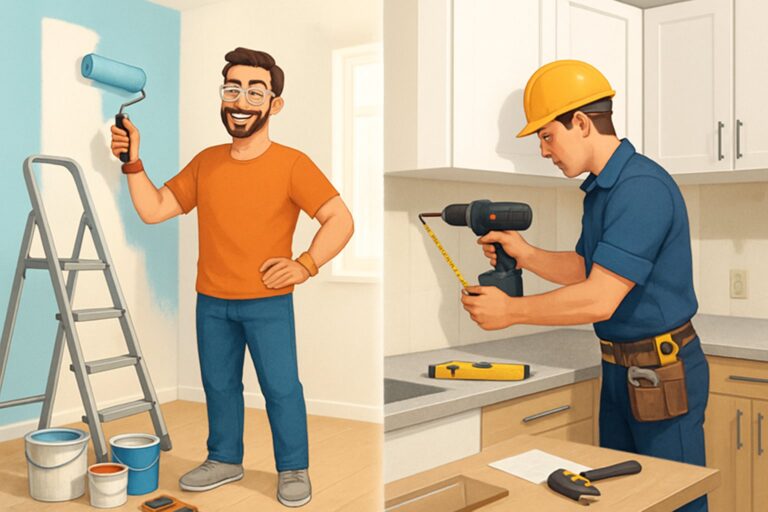Home renovation projects can feel overwhelming—especially when you’re stuck deciding whether to tackle the work yourself or bring in professionals. This choice shapes your budget, your schedule, and even the final look of your home.
And let’s be honest, the wrong call can mean expensive mistakes, safety headaches, or just a project that doesn’t turn out the way you hoped.

The key to deciding between DIY and hiring help really comes down to three things: your skills, how tricky the project is, and whether there are safety concerns.
Simple stuff—painting, swapping out cabinet hardware—usually works for DIY. But if you’re dealing with electrical, plumbing, or anything that messes with the bones of your house, you’ll want a pro.
Need a Home Fix – Emergency or Routine?
From leaks and no-heat nights to simple tune-ups, our 24/7 hotline connects you with trusted local pros in minutes.
Key Takeaways
- Think about your skills, your free time, and how complicated the project is before you jump in
- DIY is great for painting and small repairs, but pros should handle electrical, plumbing, and anything structural
- Don’t forget to factor in total costs, safety, and how long you want your results to last
Key Factors to Consider Before Choosing DIY or a Professional
Before you decide, take a hard look at what you can actually do and what the project needs. Your skills, how tough the job is, and the time you realistically have all matter.
Assessing Your Skill Level and Expertise
Be honest with yourself about what you can handle. Basic stuff like painting or putting up shelves? That’s usually fine for most folks with some patience and a few tools.
Intermediate jobs—think tiling or small plumbing fixes—take a bit more know-how and confidence.
Advanced renovations like electrical, major plumbing, or anything that changes your home’s structure? I’d say leave those to people who do this for a living. Messing up here isn’t just expensive—it can be dangerous.
Ask yourself:
- Have I done something like this before?
- Am I comfortable with special tools?
- Do I know the building codes or need permits?
- Can I fix things if they go sideways?
If you’ve got carpentry chops, sure, install those cabinets. But if you need new wiring for under-cabinet lights, get an electrician.
Fixing a botched DIY job can cost way more than hiring a pro in the first place. A homeowner who tries electrical work without experience might end up paying $1,500 or more to fix what went wrong.
Understanding Project Complexity
Complexity isn’t just about difficulty. Easy projects have clear steps, basic tools, and not much risk if you mess up.
But the tricky ones? They involve different systems, special gear, and real safety issues.
Low-complexity projects:
- Painting inside
- Simple landscaping
- Swapping out fixtures where the connections are already there
High-complexity projects:
- Remodeling kitchens
- Roof fixes
- HVAC installs
- Big plumbing changes
Big projects can reveal surprises—old wiring, hidden water damage, you name it. Pros know how to pivot and keep things moving.
Building codes and permits can get complicated fast. Contractors usually know what’s needed and can deal with the red tape.
Evaluating Time Commitment and Availability
Time-consuming projects need a real look at your schedule. DIY always takes longer since you’re learning and working around life.
A bathroom remodel that a pro crew does in a week might drag on for months if you’re only working weekends.
| Factor | DIY Impact | Professional Impact |
|---|---|---|
| Learning curve | Adds 50-100% to timeline | None |
| Tool acquisition | Extra trips to the store | Already have tools |
| Mistake correction | Can double your time | Usually quick fixes |
| Permit process | Research and waiting | Handled fast |
Be honest about how many hours you can really put in. If you only have weekends, a big project could take over your life for way longer than you expect.
Emergencies are a different story. If a pipe bursts or the power goes out, call a pro—no matter what. It’s just not worth the risk of waiting or trying to fix it yourself when things are urgent.
Common Home Renovation Projects: Which Are Best for DIY?

Some projects are perfect for DIY, while others really aren’t. Painting and small upgrades are a good way to dip your toes in, and minor fixes help you get more comfortable and save a few bucks.
Painting and Cosmetic Upgrades
Painting a room is about as DIY-friendly as it gets. Most people can handle a standard room in seven hours, start to finish.
Cost is a big plus here. Painting a 120-square-foot room yourself might run $800, while hiring it out could cost $3,000.
You’ll need:
- Brushes, rollers, drop cloths—nothing fancy
- Some patience for taping and doing two coats
- A steady hand for the edges
There’s not much danger unless you’re climbing high ladders. If your ceilings are over 10 feet, maybe think about hiring someone.
Wallpaper’s gotten easier too, thanks to peel-and-stick. DIY costs about $4 per square foot, compared to $9 for a pro.
Minor Repairs and Maintenance
Little repairs are a great way to build skills and confidence. These jobs are usually safe and inexpensive.
Easy DIY repairs:
- Caulking windows and doors
- Quieting squeaky hinges
- Patching small drywall holes
- Replacing weatherstripping
Most of these take a couple hours and cost less than $50. If you mess up, it’s rarely a big deal.
Even replacing a toilet isn’t as scary as it sounds. Shut off the water, drain the old one, then bolt in the new toilet—basic tools do the trick.
Pros might charge $200 or more, but you can do it for half that in a couple hours if you’re careful.
Simple Cabinetry and Hardware Installation
Swapping out cabinet hardware or doors is another good DIY win. These jobs don’t mess with the structure—just the look.
Cabinet hardware changes need a drill and a screwdriver. You can redo a whole kitchen in an afternoon.
Hardware costs $3-15 per piece, and hiring someone adds another $5-10 for each one.
Changing cabinet doors is pretty straightforward if you’re keeping the frames. Just measure right and use a screwdriver.
Kitchen fixtures like faucets or sinks can save you about $135 each in labor. Plan for two hours per fixture and brush up on basic plumbing.
But be ready for leaks. Always turn off the water, and have a plan if things go sideways.
Projects That Require Hiring a Professional

Certain home renovation projects come with real safety risks, legal hoops, or skills you just can’t fake. Electrical, plumbing, and structural work almost always call for a pro—often with permits and inspections required.
Electrical Work
Electrical work is risky—fires, shocks, even fatal accidents can happen if you don’t know what you’re doing.
Licensed electricians know the codes and how to keep things safe. They install circuits, upgrade panels, and wire outlets the right way. Most places require permits for electrical jobs, and your insurance might not pay if you DIY and mess up.
Call a pro for:
- New circuits or outlets
- Panel upgrades
- Running wires through walls
- Installing ceiling fans or chandeliers
- Anything with the main electrical panel
Changing light bulbs or swapping outlet covers is fine for most people, but wiring? That’s a job for someone licensed and insured.
Plumbing Work
Plumbing mistakes can flood your house and cost a fortune. Professional plumbers have the tools and know-how to deal with pipes and water pressure safely.
Big plumbing jobs usually need permits and inspections. Licensed plumbers know the codes and make sure everything’s safe. They also carry insurance in case something goes wrong.
Hire a pro for these plumbing jobs:
- Moving or installing new water lines
- Replacing water heaters
- New toilets or sinks
- Main water line repairs
- Anything with gas lines
Unclogging drains or swapping faucet handles? You can probably handle those. But anything with water supply or sewage—don’t risk it. Let a professional take over and save yourself a headache.
Structural Changes and Building Codes
Structural changes really impact a home’s safety and stability. These kinds of modifications need engineering know-how and have to meet strict building codes to keep people safe.
Things like load-bearing walls, foundation work, and roof changes definitely need a pro’s assessment. Structural engineers figure out weight loads and make sure the changes won’t mess up the building’s integrity.
Most structural work needs permits. You can’t skip that step, even if it feels like a hassle.
Projects requiring professionals:
- Removing or modifying load-bearing walls
- Foundation repairs or additions
- Roof structural changes
- Adding new windows or doors in exterior walls
- Any work affecting the home’s frame
Building codes change from place to place—and honestly, they change pretty often. Good contractors stay on top of all that and can handle the permit maze for you.
They also know how structural changes can mess with electrical, plumbing, or HVAC systems. It all connects in a house, whether we like it or not.
The Benefits and Drawbacks of DIY Renovation
DIY renovation can save a ton of money and gives you full creative freedom. But let’s be honest—it also brings risks of expensive mistakes and some real safety hazards.
Knowing these trade-offs helps you make smarter calls about your home improvement plans.
Cost Savings and Flexibility
The big win with DIY is saving on labor. Most contractors charge $50-100 an hour, and that adds up fast.
If you do the work yourself, you can cut renovation costs by 40-60%. You skip the labor fees and the markup on materials.
DIY means you get to call the shots. Pick your paint, your fixtures, your finishes—change your mind halfway through if you want, and you won’t get charged extra.
There’s also the perk of time flexibility. You work on your own schedule, not some contractor’s calendar.
Every project teaches you something new. Even simple stuff like painting or swapping a faucet builds skills for next time.
You can break big projects into stages, spreading out the cost and the work. No need to do it all at once.
Potential Risks and Common Mistakes
Your skill level really matters. Complicated jobs like electrical or plumbing need specific training and the right tools.
Common DIY mistakes include:
- Poor measurements leading to waste
- Wrong materials for the job
- Safety code violations
- Improper installations
Fixing these errors can cost more than just hiring a pro from the start. Some mistakes even create safety hazards or hurt your home’s value.
Hidden costs sneak up. Renting tools, getting permits, and making endless trips to the store all add up. It’s not unusual to go 20-30% over budget.
People almost always underestimate the time involved. That “quick” bathroom update? It can take weeks if you’re new to this. Rushing can make the quality suffer, too.
Some insurance policies don’t cover damage from unpermitted or badly done DIY work. It’s worth checking before you start swinging a hammer.
The Advantages and Disadvantages of Hiring a Pro
Pros bring specialized skills and guaranteed quality to the table. But hiring one means higher costs and giving up some control over how things get done.
Expertise and Quality Assurance
Contractors have years of experience and training. They know building codes and safety rules most homeowners don’t even realize exist.
Hiring a pro usually means the work gets done faster. Contractors have the right tools and people for the job.
Quality tends to be higher with professionals. They use better techniques and materials, and most offer warranties.
They can spot problems early and know how all your home’s systems fit together. That’s a big deal when you’re messing with plumbing or wiring.
Contractors deal with permits and inspections, so you don’t have to stress about paperwork or approvals.
Costs, Scheduling, and Control
Hiring a pro costs more upfront. Labor is a big chunk of any renovation budget, and pros have to pay their teams and cover business costs.
Still, good work can save you money in the long run. Quality installations last longer and need fewer repairs. Contractors also get better deals on materials.
Scheduling can get tricky. The best contractors book up fast, sometimes months ahead. Weather and other jobs can slow things down, too.
You’ll have less say in the day-to-day. Contractors make a lot of choices about materials and methods, and not everyone likes giving up that control.
Communication matters, but it’s not always perfect. Sometimes contractors don’t update you as much as you’d like. A clear contract helps keep everyone on the same page.
How to Decide: Making the Right Choice for Your Home Improvement
Good home improvement decisions really come down to weighing costs, time, and safety. Knowing your codes and long-term implications helps you avoid expensive headaches and get the results you want.
Budgeting and Planning
Initial Cost Analysis
Budgeting for renovations means more than just adding up material prices. Don’t forget tool rentals, permits, or the cost of fixing mistakes—those add up fast when comparing DIY and pro options.
DIY looks cheaper at first. But about a quarter of homeowners end up surprised by unexpected costs during self-managed projects.
Time Investment Calculations
Big projects take real time, so be honest about your schedule. Painting a room might eat up a couple weekends, but bigger jobs can drag on for months.
Contractors usually finish 3-4 times faster than DIYers. That speed matters, especially if you’re remodeling a kitchen or bathroom you use every day.
Hidden Expenses
| Cost Factor | DIY Risk | Professional Benefit |
|---|---|---|
| Tool Purchase/Rental | $200-$2,000+ | Included in service |
| Permit Applications | Time + fees | Handled by contractor |
| Mistake Corrections | Up to 50% of project cost | Warranty protection |
Safety, Legal, and Long-Term Implications
Building Code Compliance
Building codes cover electrical, plumbing, and structural work in most places. Contractors know the local rules and make sure you have the right permits.
DIYers can get hit with fines, failed inspections, or denied insurance claims if they skip the rules. Around 30% of DIY electrical jobs fail inspections—yikes.
Safety Considerations
High-risk jobs like electrical, gas, or major structural changes really should go to the pros. Bad installs can cause fires, floods, or even collapse.
Long-term Value Protection
Pro work usually comes with warranties and insurance. That protects your home’s value and saves you from big repair bills later.
Bad DIY jobs often need fixing by a pro anyway. Unfortunately, the double cost can end up 40-60% higher than just hiring someone in the first place.
Frequently Asked Questions
People ask all the time about skill levels, legal stuff, and costs when choosing between DIY and hiring out. Safety and how complicated the job is make a big difference, too.
How can I assess whether a renovation project is within my skill level?
Think about what you’ve done before. If you’ve never used a saw, maybe skip building cabinets or framing walls for now.
Weigh the risks of mistakes. Messing up paint is annoying, but wiring errors can be dangerous—or even deadly.
Start small to build confidence. Try tiling a little bathroom before you tackle the whole kitchen backsplash.
Look up step-by-step guides and watch a few videos. Know what you’re getting into before you start.
What are the legal or permitting implications of doing a renovation myself versus hiring a professional?
Most cities require permits for electrical, plumbing, or structural work. Homeowners can usually pull permits themselves, but you have to follow the same rules as the pros.
Some places only let licensed contractors do certain jobs, especially electrical or gas work. Check your local regulations first.
Insurance might not cover problems from unpermitted DIY work. Read your policy before starting anything big.
Unpermitted work can cause trouble when selling your home. Buyers may want permits fixed after the fact or negotiate the price down.
At what point in a renovation does it become more cost-effective to hire a professional?
It’s worth paying for labor when fixing mistakes would be expensive. For example, pro tile work costs more upfront but saves you from redoing a botched job.
Your own time matters, too. If you make $50 an hour at work, it might be cheaper to pay a contractor than use up vacation days for DIY.
Buying specialty tools for one project can cost more than hiring someone who already owns them. That’s easy to overlook.
If a project needs plumbers, electricians, and carpenters, it’s usually more efficient (and less stressful) to hire a general contractor.
How do I determine the time commitment required for a DIY renovation compared to professional work?
Pros work faster because they’ve done it before and have the right tools. A kitchen remodel might take them two weeks, but you could be working weekends for two months.
Don’t forget learning time. Researching, watching tutorials, and practicing can eat up hours before you even start the real work.
DIY projects often spill into nights and weekends, while pros work during the day. That can disrupt your routine.
Expect more trips to the store than you think. Contractors usually have everything ready, but DIYers end up running out for forgotten supplies.
What are safety concerns to consider when deciding to DIY or to call in a professional contractor?
Electrical work can cause shocks or fires if you don’t know what you’re doing. Even swapping outlets is riskier than it looks.
Structural changes can weaken your house. Removing the wrong wall can lead to real damage.
Lead paint and asbestos need special handling. Stirring up those materials without the right gear is dangerous for everyone in the home.
Working on ladders or roofs is risky. Pros have the equipment and experience to do those jobs safely.
How does the complexity of renovation impact the decision between DIY and hiring a professional?
Simple projects with just a few steps? Those are perfect for DIY. Painting rooms, putting up shelves, or doing some basic landscaping usually have straightforward instructions and low risk if you mess up.
If you need permits or inspections, it’s probably smarter to hire a pro. Pros know the codes inside out and can usually get things approved right away.
Some projects have a bunch of steps you have to do in the right order. Take kitchen renovations—there’s demolition, plumbing, electrical, and installation, and you need to juggle all of them just right.
Trades like plumbing and electrical aren’t something you pick up overnight. They take years to master, with all the codes and safety rules, and honestly, most DIYers just don’t have that kind of expertise.







Leave a Reply